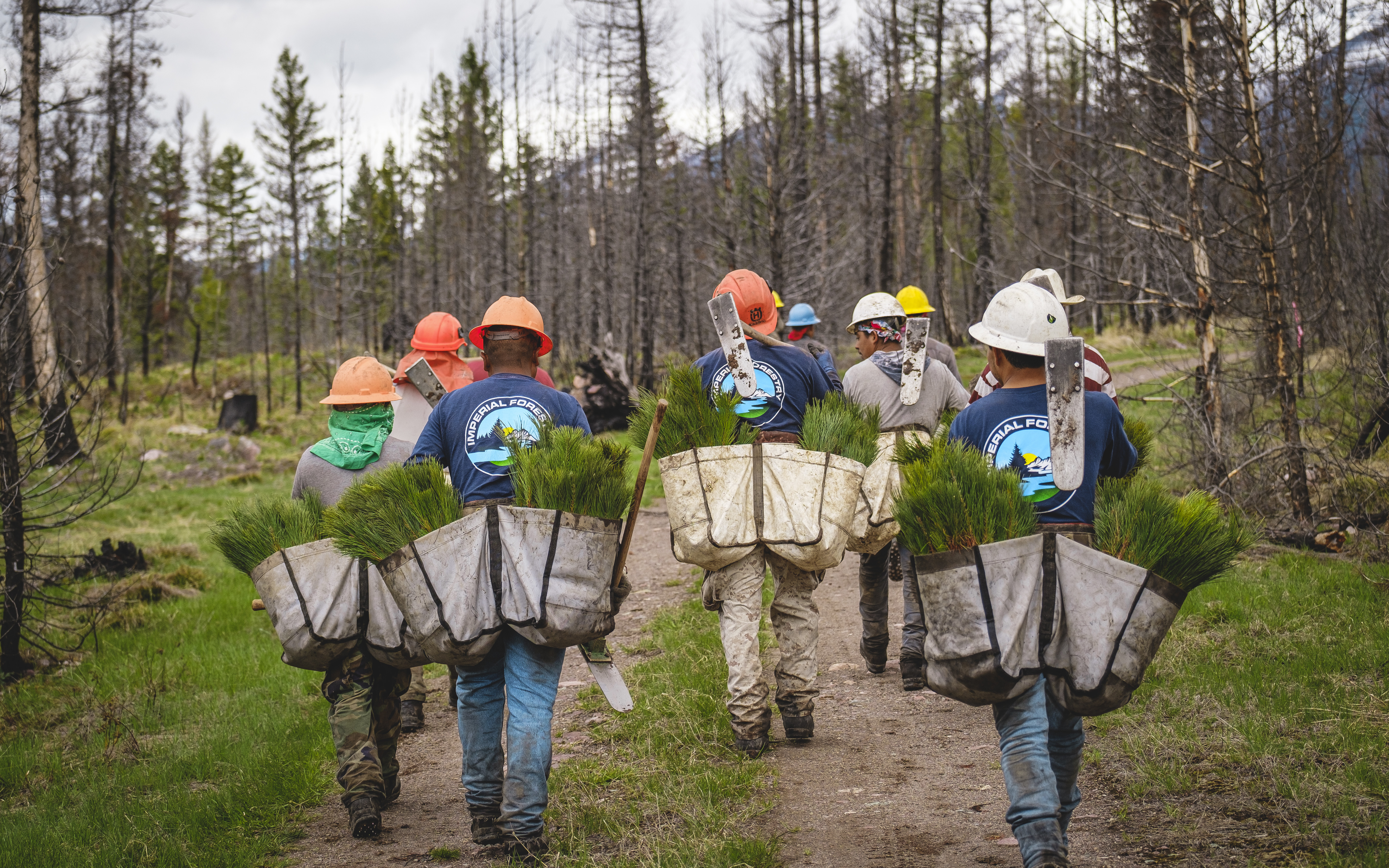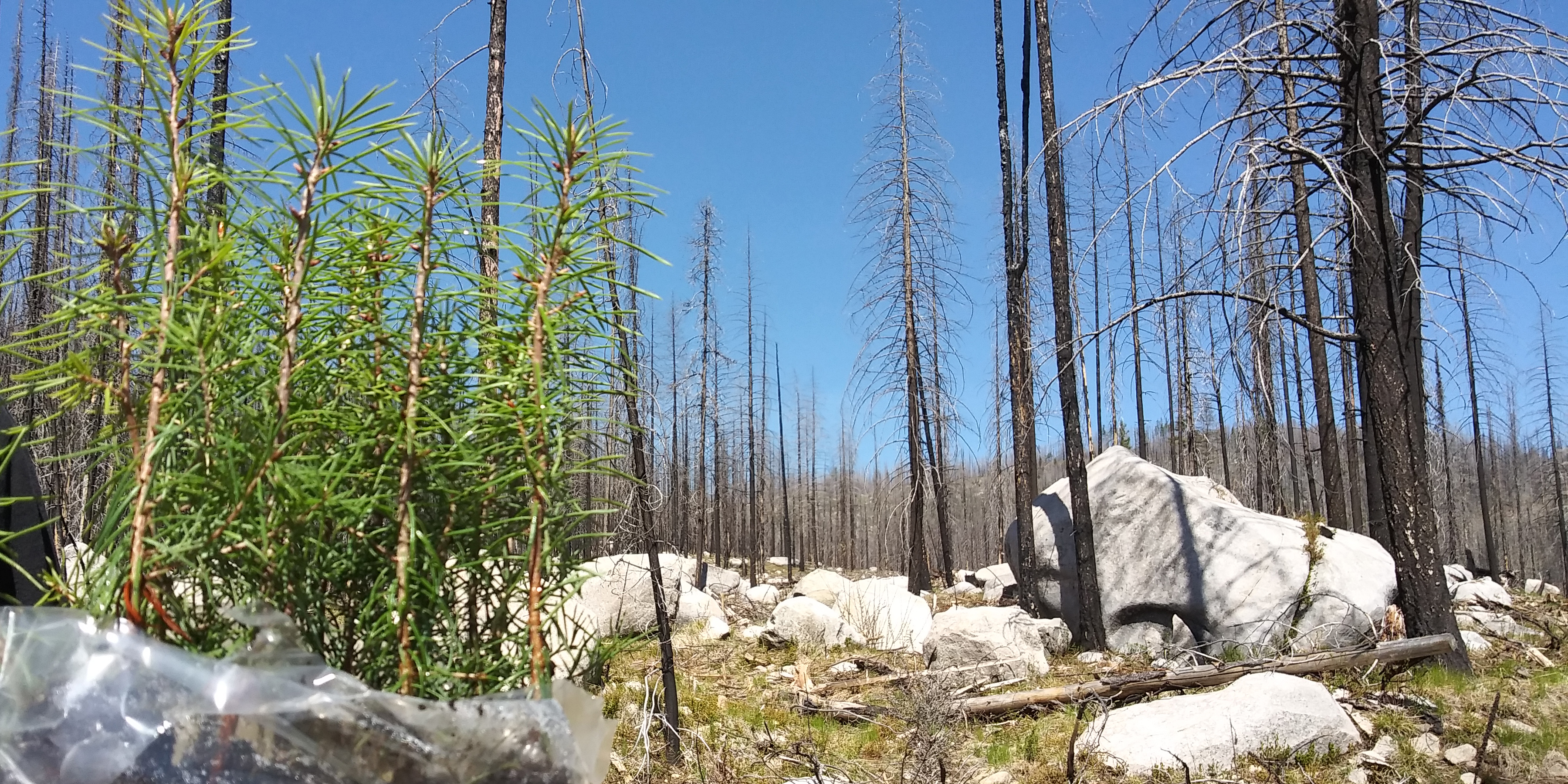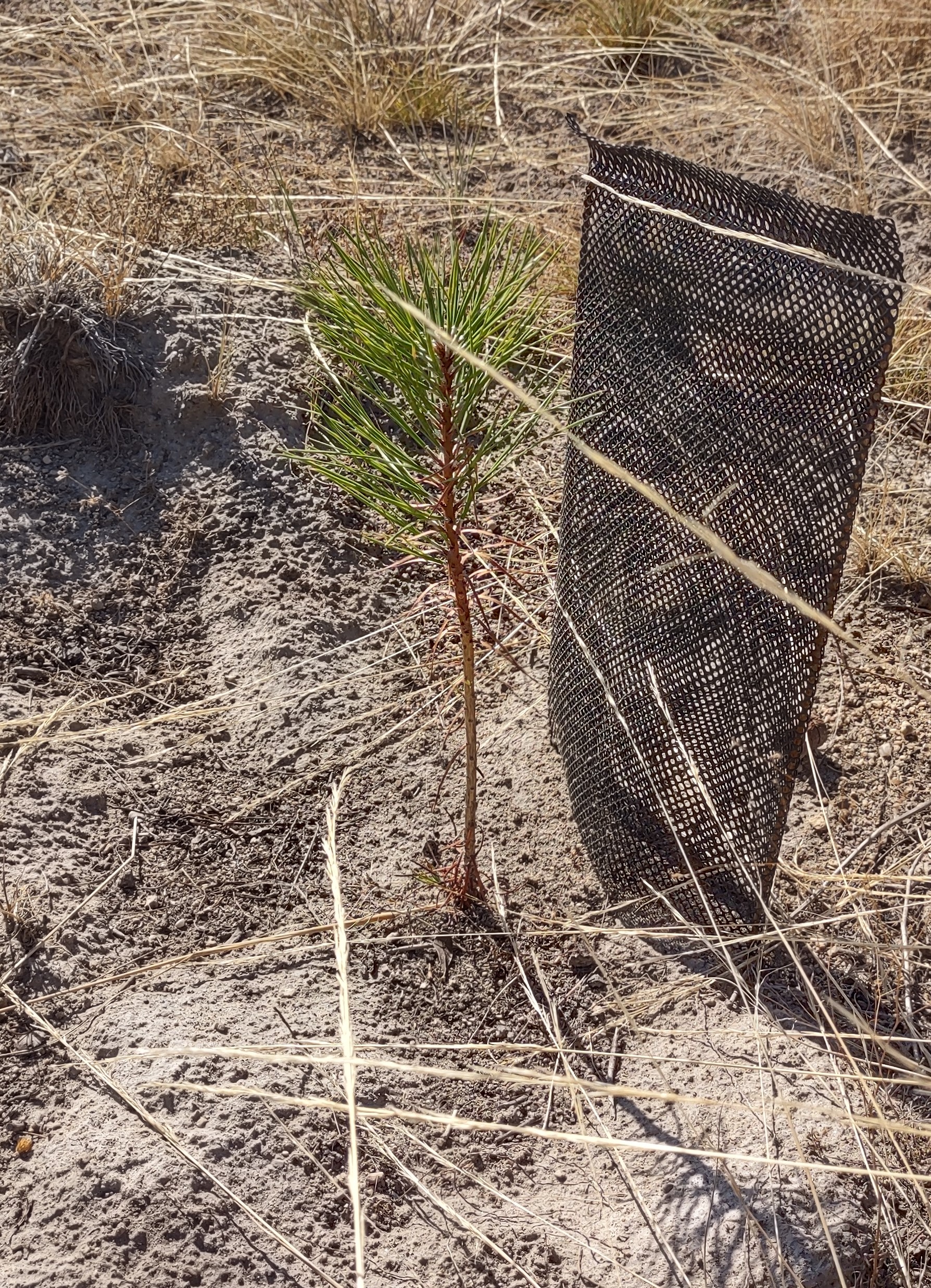To help adapt national forests to climate change, land managers implemented assisted population migration trials in Washington’s Okanogan-Wenatchee and Gifford Pinchot National Forests. They began by identifying sites in need of reforestation due to disturbance from wildfire or timber harvests. Then, the team selected and planted seeds adapted to the future climate of the planting sites. Assisted population migration trials could improve our understanding of climate resilience on national forests.
Reading Time| 8 minutes
Management Goals| Evaluate the success of assisted population migration using seeds adapted to warmer conditions like those expected in Washington’s future.
Audience | Foresters, Forest Managers, Forest Landowners, Researchers
Project Contact | Andrew Bower
Project Area | Okanogan-Wenatchee and Gifford Pinchot National Forests
 A reforestation crew hikes into a recent burn scar to plant conifer seedlings. Credit: Dave Gardner Creative/National Forest Foundation
A reforestation crew hikes into a recent burn scar to plant conifer seedlings. Credit: Dave Gardner Creative/National Forest Foundation
Forest managers in the Northwest have a lot of experience planting trees. However, this task is becoming more complex with climate change, and managers may have to test out new approaches to reforestation to adapt forests to future climates.
Forests and woodlands are locally adapted to climate and tolerate moderate changes. However, as temperatures increase and precipitation patterns become more variable, disturbance from drought, wildfire, insects, and disease may outpace the capacity of some tree species to adapt in place or migrate to more suitable habitats. Trees in the Northwest are expected to experience shifts in distribution due to climate change. Some species, like Douglas-fir, are likely to shift to higher elevations or northward, whereas dry interior forests, more tolerant of low soil moisture, could expand. Forests like high-elevation cold coniferous forests of whitebark pine and subalpine fir are likely to shrink as warming temperatures allow more productive forest types to move into their habitats.
Natural migration of trees is a long process because seeds must travel via wind or animals. In addition, once a seed arrives and grows in a new location, it can take several decades for a tree to reach reproductive maturity. Climate change may further limit natural regeneration opportunities in places where disturbances are frequent (e.g., reburns that kill young trees). To speed up the process of seed migration, geneticists and forest managers are exploring climate adaptation actions that could help Northwest tree species survive climatic changes. One such management action is assisted population migration, or human-assisted movement of a species’ seeds from one zone to another in response to climate change. Assisted population migration can mimic natural migration, but at a faster pace, helping find seeds that may be better adapted to future climates.
Within a tree species, genetic variation makes it easier for individual trees to adapt to different climates. As such, seeds from a lower elevation with a warmer climate could be planted at a higher elevation to match the climate in the future. For example, if a fire burned through a ponderosa pine stand at 3,700 feet elevation on the Okanogan-Wenatchee National Forest, forest managers could replant the site with seedlings from ponderosa pine located at 3,000 feet elevation so that these seedlings are suited for a warmer future.
Assisted population migration trials in other areas of North America (including one in which whitebark pine seeds from Oregon and Washington grew successfully in northern British Columbia) have been effective in helping vulnerable tree species move to sites with suitable current and future climates. Sites with recent disturbances (e.g., wildfire, timber harvest, or landslide) are logical locations for assisted population migration because reforestation projects are already planned.
In 2021, on the Okanogan-Wenatchee and Gifford Pinchot National Forests of Washington, climate adaptation specialist Andrew Bower, regional geneticist Vicky Erickson, and emeritus research geneticist Brad St. Clair planned assisted population migration trials to inform decisions about climate-resilient forest management in the Northwest.
Climate Change Impacts of Concern
Assisted population migration trials address several impacts of climate change in Northwest forests. These trials could contribute to the survival of tree species, and maintain forest productivity, carbon storage, and wildlife habitat while adapting forests to climate change.
Climate change projections for 2080 suggest an increase in average annual temperature of 4.7–10.0°F in Washington. Precipitation projections are more uncertain, though in Washington, a slight increase in winter precipitation, a slight decrease in summer precipitation, and more extreme precipitation events may occur. As temperatures warm, lower snowpack is expected, with more precipitation falling as rain than snow and snowpack melting earlier, resulting in longer dry seasons. Higher temperatures and longer periods between precipitation events could cause more frequent and severe droughts.
Implementation
These assisted population migration trials mimic normal reforestation efforts, but use seedlings thought to be better adapted to future climates of the sites, in addition to seedlings from the site location. The team identified sites in need of reforestation on the Okanogan-Wenatchee and Gifford Pinchot National Forests. Andrew Bower contacted local (district and forest) silviculturists for sites recently affected by wildfire, timber harvest, or other disturbances. The Carleton site (red pin on map), a recently burned area on the Okanogan-Wenatchee, was selected for assisted population migration of ponderosa pine. On the Gifford Pinchot, the Randle site (purple pin on map), a recent timber harvest, was chosen for assisted population migration of Douglas-fir.
The next step was identifying seeds from current natural populations thought to be better adapted to projected future climates (e.g., sites with warmer conditions, lower water availability). However, the chosen seedlings had to be able to survive in the current climate and future climates of the planting sites. For this portion of the trials, the team used the Seedlot Selection Tool to identify seed sources from locations where the current climate matched the expected future climate of the planting sites. They considered four time periods under climate scenario RCP 8.5 (a high emissions scenario) for choosing appropriate seed source locations: (1) current climate of the site, (2) near-future (2010–2040), (3) mid-century (2040–2070), and (4) late-century (2070–2100). Bower notes that “from a geneticist’s viewpoint, you want to find that sweet spot where a seed is adapted to a warmer climate, but can also withstand a colder, frost-prone current climate.”
Following seed source identification, the team used the U.S. Forest Service Pacific Northwest region’s seed inventory at the Bend Seed Extractory and J. Herbert Stone Nursery to determine appropriate seedlots. Using current and future data on climate variables related to the planting sites and seedlots, the team calculated the distance between planting sites and seed sources (climatic transfer distance). Chosen seedlots had the smallest climatic transfer distance between the seedlot and planting site.
For each site, four different groups of seedlings were grown for the four climate scenarios. Seedlings were nursery-grown and planted using the same methods as seedlings grown for normal reforestation projects. Randomized 1.5-acre blocks of each seedlot were copied four times across the landscape to reduce the effect of local environmental differences on trial variables. Planting occurred in the fall of 2021. The Carleton site was planted with 200 ponderosa per acre, whereas and the Randle site was planted with 150 Douglas-fir per acre. Shade cards were installed next to the seedlings at the Carleton site to give protection from hot afternoon sun. One-year-old, bare-root seedlings were planted by contract crews at both sites.
Outcomes
 Seedlings are often planted in recently burned or timber harvested regions of forests. Credit: Joseph M. de Leon, USFS
Seedlings are often planted in recently burned or timber harvested regions of forests. Credit: Joseph M. de Leon, USFS
The Okanogan-Wenatchee and Gifford Pinchot trials have been absorbed into a larger research project led by research forester Robert Slesak of the Pacific Northwest Research Station. Slesak plans to install 20 similar sites throughout California, Oregon, and Washington to assess the effectiveness of assisted population migration. Bower suggests monitoring may take place at 1, 3, and 5 years post-planting, and then every 5 years thereafter. Survival and growth will be monitored to determine differences between seed sources and seed source performance.
Bower comments that “Managers would be able to see how different seed sources competed using real-time data. This is not just a project that is feeding into research, it’s something that’s actually practical.” The trials also have utility as adaptation projects and demonstration sites that the forests can highlight. “Silviculture conferences could attend field visits to these sites,” Bower remarks, as well as many additional opportunities for public engagement.
Challenges
Using assisted population migration as a management tool comes with some dilemmas. Scientists and land managers are unsure whether assisted population migration will work. These trials are necessary because they will help scientists determine the usefulness of assisted population migration. Another consideration is that chosen seeds could be adapted to the specific soil and fungus conditions of where they currently are, and if moved, could fail to thrive. Introduced seedlings may also carry insects and pathogens that could affect local trees and could have lower resistance to insects and pathogens native to the location they are planted.
Communication is both a challenge and an opportunity of assisted population migration, as its success requires a lot of conversations between scientists, forest employees, and nurseries. Bower had to reach out to individuals on each national forest to determine availability and interest for assisted population migration sites. Collaboration with local silviculturists and nursery employees was crucial to the project’s success.
Finding useable seeds from selected seedlot locations was an additional challenge. In recent years, the Forest Service has completed fewer harvests and seed collections, resulting in depleted seed inventories and potentially lower germination rates for older seed. Bower emphasizes the importance of a strong “reforestation pipeline,” with additional resources dedicated to seed collection and nursery seedling production.
There were also operational challenges to the project. At the Randle site on the Gifford Pinchot National Forest, snow fell on the site a week before planting occurred, making access to the site challenging and increasing the risk that seedlings may be exposed to frost. Late frost, precipitation events, and drought are all considerations for planting seedlings.
Opportunities
 A shade-card protects this ponderosa seedling from hot afternoon sun at the Carleton site. Credit: Andrew Bower
A shade-card protects this ponderosa seedling from hot afternoon sun at the Carleton site. Credit: Andrew Bower
Assisted population migration could help to keep forests healthy and productive under climate change by increasing the future likelihood of success for a species. Healthy forests mean a greater capacity for carbon storage, wildlife habitat, and drinking water filtration. In addition, assisted population migration can help vulnerable tree populations and species move across barriers in landscapes that have been fragmented by infrastructure, agriculture, and other land use practices. Because assisted population migration may be an effective tool in adaptive forest management, it will be important to resolve ongoing ethical concerns about its implementation. These efforts in Washington are not the only examples of national forest managers testing out assisted population migration. On the Umpqua National Forest, managers have installed similar trials for sugar pine in areas burned in recent wildfires.
Tools Used
The team used the Seedlot Selection Tool, which helps foresters, landowners, and land managers to consider climate change when planning reforestation and afforestation projects. This online tool maps climate variables that are important to tree growth, reproduction, and survival. Forest landowners and natural resource managers can use this tool to explore options for responding to climate change by determining where seeds or seedlings can be sourced so that they are suited to current and future climates. There is also a guidebook and upcoming video tutorial to help silviculturists use the tool.



